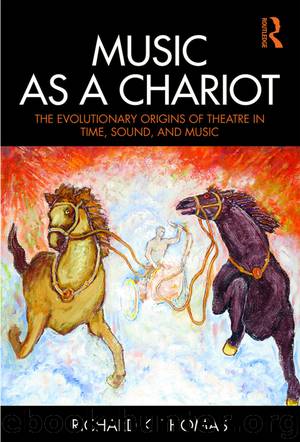Music as a Chariot by Richard K. Thomas

Author:Richard K. Thomas [Richard K. Thomas]
Language: eng
Format: epub
Tags: Digital Media
Publisher: Focal Press
Published: 2018-02-02T05:00:00+00:00
Harmony
For me, creating melodies and then orchestrating them to score scenes is much more of a craft than finding a tune that metaphysically transcends “any succession of single tones.” I learned this from Jack Smalley, or more properly from his book Composing Music for Film (Smalley 2005). Jack Smalley is a prolific composer of music for film and television. Unlike this author, Smalley is a man of few words, but he chooses them carefully and makes every one count. He wrote a short, amazingly concise book that provides a wealth of precise techniques for composing and orchestrating music for film. You have to order the book directly from Mr. Smalley, but it’s well worth it, and I highly recommend it. The most important thing he taught me was how to craft a score, and not to worry about inspiration. Smalley starts from the development of a theme—not a tune, but the smallest group of notes you can form into an identifiable, useable shape, typically one, two or three measures long. One then develops this theme systematically into a complete movie score. As I’ve mentioned before, the opportunities to create and use a memorable tune in theatre are somewhat rare. The opportunities for crafting a cohesive sound score in theatre are almost endless.
Line (melody) usually plays a somewhat diminished role in theatre scoring due to the simple fact that the actors, playwright and director have already crafted the lead melodies using the prosody of dialogue. Our job as composers and sound designers then becomes to orchestrate those melodies, and there’s plenty we can do with consonance and dissonance to incite emotions in our audience beyond melody, and—significantly differing from film—in our actors. In film the score happens after the actors have “left the building,” so to speak. In theatre, the actors also experience the underscores we create, a point that theatre composers must never forget. It is a much more intimate experience composing music for live theatre, because we share the character with the actor in a much more concrete way. Get the scoring right and the actor will adore you. Mess it up and the actor may try to get you fired.
We don’t necessarily need musical instruments to score the actor’s prosody either. The room tone, or a silent recording of the ambience in a room (which is not really silent at all!), can be manipulated for consonance and dissonance over long periods of time. I used such a technique with the (synthesized) wind in the cave for Joel Fink’s production of Edgar Allen Poe’s Cask of Amontillado in Chicago; manipulating it from a relative consonance when Montressor and Fortunato first entered to a stronger dissonance as the scene turned ugly and Montressor walled up Fortunato in the niche of the wine cellar. I almost never let my ambiences just sit in a scene; I actually learned that trick from my old partner Brad Garton, who taught me that, in music synthesis, never let sustained tones sit unchanged. Always put some sort of subtle movement into them, otherwise, their constancy will draw attention to itself.
Download
This site does not store any files on its server. We only index and link to content provided by other sites. Please contact the content providers to delete copyright contents if any and email us, we'll remove relevant links or contents immediately.
| Dance | Individual Directors |
| Magic & Illusion | Reference |
| Theater |
Call Me by Your Name by André Aciman(20348)
Ready Player One by Cline Ernest(14491)
How to Be a Bawse: A Guide to Conquering Life by Lilly Singh(7360)
Wiseguy by Nicholas Pileggi(5645)
The Kite Runner by Khaled Hosseini(5061)
On Writing A Memoir of the Craft by Stephen King(4847)
Audition by Ryu Murakami(4821)
The Crown by Robert Lacey(4710)
Call me by your name by Andre Aciman(4598)
Gerald's Game by Stephen King(4554)
Harry Potter and the Cursed Child: The Journey by Harry Potter Theatrical Productions(4427)
Dialogue by Robert McKee(4305)
The Perils of Being Moderately Famous by Soha Ali Khan(4156)
Dynamic Alignment Through Imagery by Eric Franklin(4096)
Apollo 8 by Jeffrey Kluger(3618)
Seriously... I'm Kidding by Ellen DeGeneres(3563)
The Inner Game of Tennis by W. Timothy Gallwey(3557)
How to be Champion: My Autobiography by Sarah Millican(3544)
Darker by E L James(3463)
